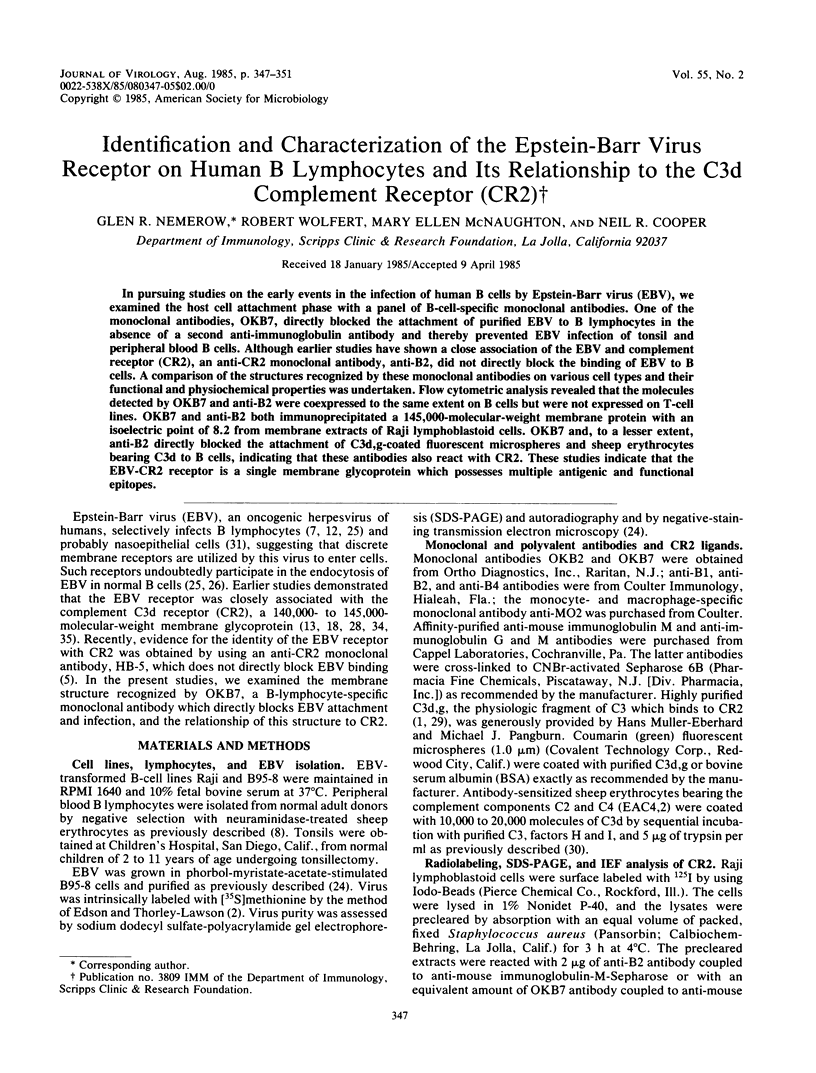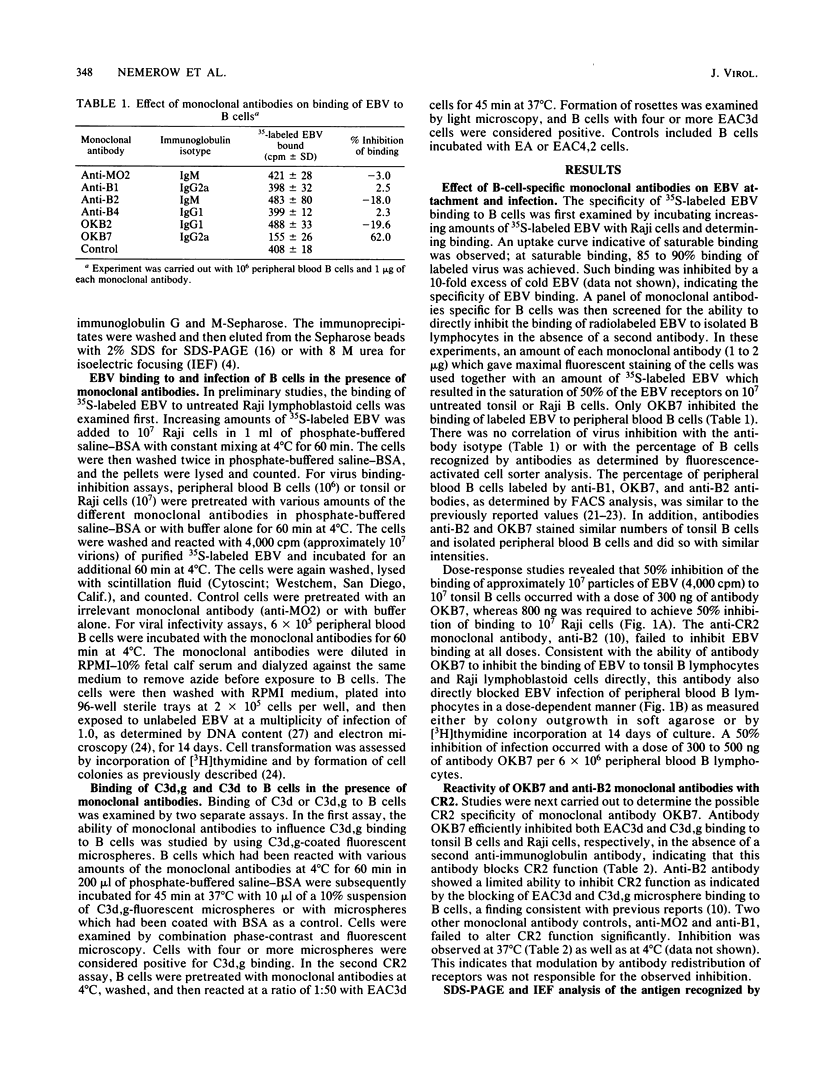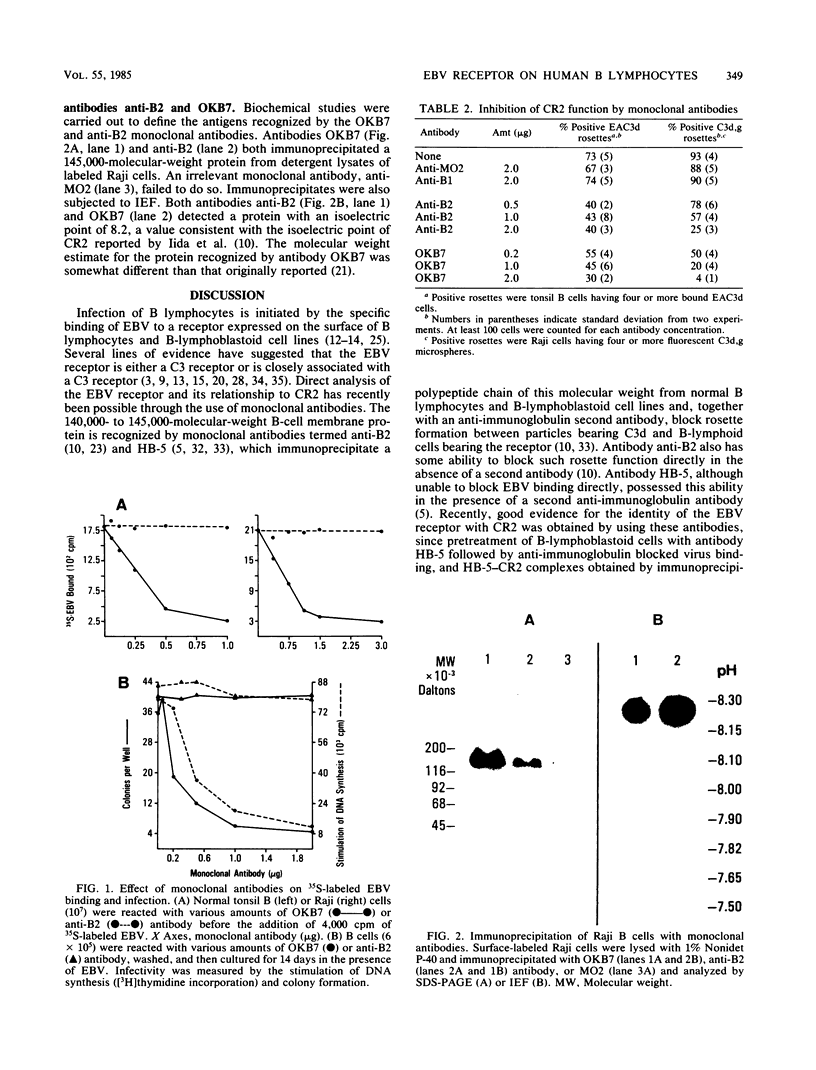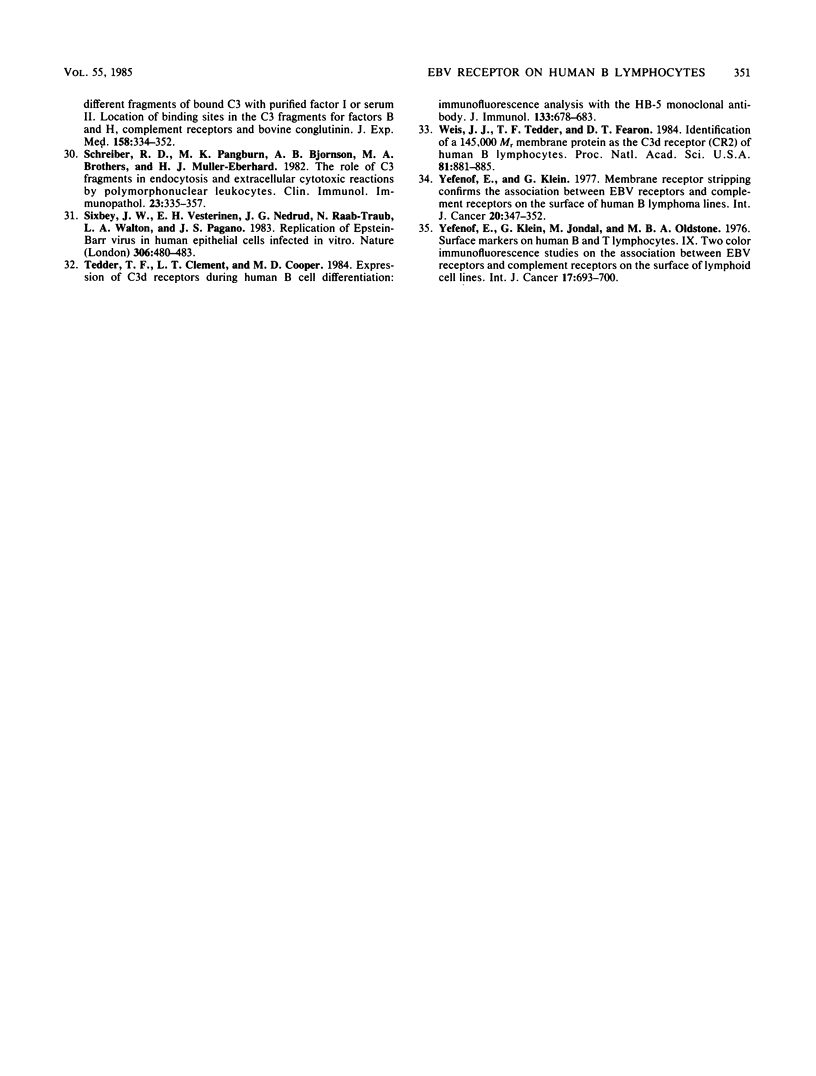Abstract
In pursuing studies on the early events in the infection of human B cells by Epstein-Barr virus (EBV), we examined the host cell attachment phase with a panel of B-cell-specific monoclonal antibodies. One of the monoclonal antibodies, OKB7, directly blocked the attachment of purified EBV to B lymphocytes in the absence of a second anti-immunoglobulin antibody and thereby prevented EBV infection of tonsil and peripheral blood B cells. Although earlier studies have shown a close association of the EBV and complement receptor (CR2), an anti-CR2 monoclonal antibody, anti-B2, did not directly block the binding of EBV to B cells. A comparison of the structures recognized by these monoclonal antibodies on various cell types and their functional and physiochemical properties was undertaken. Flow cytometric analysis revealed that the molecules detected by OKB7 and anti-B2 were coexpressed to the same extent on B cells but were not expressed on T-cell lines. OKB7 and anti-B2 both immunoprecipitated a 145,000-molecular-weight membrane protein with an isoelectric point of 8.2 from membrane extracts of Raji lymphoblastoid cells. OKB7 and, to a lesser extent, anti-B2 directly blocked the attachment of C3d,g-coated fluorescent microspheres and sheep erythrocytes bearing C3d to B cells, indicating that these antibodies also react with CR2. These studies indicate that the EBV-CR2 receptor is a single membrane glycoprotein which possesses multiple antigenic and functional epitopes.
Full text
PDF




Images in this article
Selected References
These references are in PubMed. This may not be the complete list of references from this article.
- Davis A. E., 3rd, Harrison R. A., Lachmann P. J. Physiologic inactivation of fluid phase C3b: isolation and structural analysis of C3c, C3d,g (alpha 2D), and C3g. J Immunol. 1984 Apr;132(4):1960–1966. [PubMed] [Google Scholar]
- Edson C. M., Thorley-Lawson D. A. Epstein-Barr virus membrane antigens: characterization, distribution, and strain differences. J Virol. 1981 Jul;39(1):172–184. doi: 10.1128/jvi.39.1.172-184.1981. [DOI] [PMC free article] [PubMed] [Google Scholar]
- Einhorn L., Steinitz M., Yefenof E., Ernberg I., Bakacs T., Klein G. Epstein-Barr virus (EBV) receptors, complement receptors, and EBV infectibility of different lymphocyte fractions of human peripheral blood. II. Epstein-Barr virus studies. Cell Immunol. 1978 Jan;35(1):43–58. doi: 10.1016/0008-8749(78)90125-9. [DOI] [PubMed] [Google Scholar]
- Ferreira A., Eichinger D. A simplified two-dimensional electrophoretic technique. J Immunol Methods. 1981;43(3):291–299. doi: 10.1016/0022-1759(81)90177-0. [DOI] [PubMed] [Google Scholar]
- Fingeroth J. D., Weis J. J., Tedder T. F., Strominger J. L., Biro P. A., Fearon D. T. Epstein-Barr virus receptor of human B lymphocytes is the C3d receptor CR2. Proc Natl Acad Sci U S A. 1984 Jul;81(14):4510–4514. doi: 10.1073/pnas.81.14.4510. [DOI] [PMC free article] [PubMed] [Google Scholar]
- Gerber P., Hoyer B. H. Induction of cellular DNA synthesis in human leukocytes by Epstein-Barr virus. Nature. 1971 May 7;231(5297):46–47. doi: 10.1038/231046a0. [DOI] [PubMed] [Google Scholar]
- Greaves M. F., Brown G. Epstein-Barr virus binding sites on lymphocyte subpopulations and the origin of lymphoblasts in cultured lymphoic cell lines and in the blood of patients with infectious mononucleosis. Clin Immunol Immunopathol. 1975 Mar;3(4):514–524. doi: 10.1016/0090-1229(75)90076-8. [DOI] [PubMed] [Google Scholar]
- Huddlestone J. R., Oldstone M. B. T suppressor (TG) lymphocytes fluctuate in parallel with changes in the clinical course of patients with multiple sclerosis. J Immunol. 1979 Oct;123(4):1615–1618. [PubMed] [Google Scholar]
- Hutt-Fletcher L. M., Fowler E., Lambris J. D., Feighny R. J., Simmons J. G., Ross G. D. Studies of the Epstein Barr virus receptor found on Raji cells. II. A comparison of lymphocyte binding sites for Epstein Barr virus and C3d. J Immunol. 1983 Mar;130(3):1309–1312. [PubMed] [Google Scholar]
- Iida K., Nadler L., Nussenzweig V. Identification of the membrane receptor for the complement fragment C3d by means of a monoclonal antibody. J Exp Med. 1983 Oct 1;158(4):1021–1033. doi: 10.1084/jem.158.4.1021. [DOI] [PMC free article] [PubMed] [Google Scholar]
- Inada T., Mims C. A. Mouse Ia antigens are receptors for lactate dehydrogenase virus. Nature. 1984 May 3;309(5963):59–61. doi: 10.1038/309059a0. [DOI] [PubMed] [Google Scholar]
- Jondal M., Klein G., Oldstone M. B., Bokish V., Yefenof E. Surface markers on human B and T lymphocytes. VIII. Association between complement and Epstein-Barr virus receptors on human lymphoid cells. Scand J Immunol. 1976;5(4):401–410. doi: 10.1111/j.1365-3083.1976.tb00294.x. [DOI] [PubMed] [Google Scholar]
- Jondal M., Klein G. Surface markers on human B and T lymphocytes. II. Presence of Epstein-Barr virus receptors on B lymphocytes. J Exp Med. 1973 Dec 1;138(6):1365–1378. doi: 10.1084/jem.138.6.1365. [DOI] [PMC free article] [PubMed] [Google Scholar]
- Jønsson V., Wells A., Klein G. Receptors for the complement C3d component and the Epstein-Barr virus are quantitatively coexpressed on a series of B-cell lines and their derived somatic cell hybrids. Cell Immunol. 1982 Sep 15;72(2):263–276. doi: 10.1016/0008-8749(82)90474-9. [DOI] [PubMed] [Google Scholar]
- Klein G., Yefenof E., Falk K., Westman A. Relationship between Epstein-Barr virus (EBV)-production and the loss of the EBV receptor/complement receptor complex in a series of sublines derived from the same original Burkitt's lymphoma. Int J Cancer. 1978 May 15;21(5):552–560. doi: 10.1002/ijc.2910210504. [DOI] [PubMed] [Google Scholar]
- Laemmli U. K. Cleavage of structural proteins during the assembly of the head of bacteriophage T4. Nature. 1970 Aug 15;227(5259):680–685. doi: 10.1038/227680a0. [DOI] [PubMed] [Google Scholar]
- Lambris J. D., Dobson N. J., Ross G. D. Isolation of lymphocyte membrane complement receptor type two (the C3d receptor) and preparation of receptor-specific antibody. Proc Natl Acad Sci U S A. 1981 Mar;78(3):1828–1832. doi: 10.1073/pnas.78.3.1828. [DOI] [PMC free article] [PubMed] [Google Scholar]
- Lentz T. L., Burrage T. G., Smith A. L., Crick J., Tignor G. H. Is the acetylcholine receptor a rabies virus receptor? Science. 1982 Jan 8;215(4529):182–184. doi: 10.1126/science.7053569. [DOI] [PubMed] [Google Scholar]
- Lentz T. L., Wilson P. T., Hawrot E., Speicher D. W. Amino acid sequence similarity between rabies virus glycoprotein and snake venom curaremimetic neurotoxins. Science. 1984 Nov 16;226(4676):847–848. doi: 10.1126/science.6494916. [DOI] [PubMed] [Google Scholar]
- Magrath I., Freeman C., Santaella M., Gadek J., Frank M., Spiegel R., Novikovs L. Induction of complement receptor expression in cell lines derived from human undifferentiated lymphomas. II. Characterization of the induced complement receptors and demonstration of the simultaneous induction of EBV receptor. J Immunol. 1981 Sep;127(3):1039–1043. [PubMed] [Google Scholar]
- Mittler R. S., Talle M. A., Carpenter K., Rao P. E., Goldstein G. Generation and characterization of monoclonal antibodies reactive with human B lymphocytes. J Immunol. 1983 Oct;131(4):1754–1761. [PubMed] [Google Scholar]
- Nadler L. M., Anderson K. C., Marti G., Bates M., Park E., Daley J. F., Schlossman S. F. B4, a human B lymphocyte-associated antigen expressed on normal, mitogen-activated, and malignant B lymphocytes. J Immunol. 1983 Jul;131(1):244–250. [PubMed] [Google Scholar]
- Nadler L. M., Stashenko P., Hardy R., van Agthoven A., Terhorst C., Schlossman S. F. Characterization of a human B cell-specific antigen (B2) distinct from B1. J Immunol. 1981 May;126(5):1941–1947. [PubMed] [Google Scholar]
- Nemerow G. R., Cooper N. R. Early events in the infection of human B lymphocytes by Epstein-Barr virus: the internalization process. Virology. 1984 Jan 15;132(1):186–198. doi: 10.1016/0042-6822(84)90102-8. [DOI] [PubMed] [Google Scholar]
- Nemerow G. R., Cooper N. R. Infection of B lymphocytes by a human herpesvirus, Epstein-Barr virus, is blocked by calmodulin antagonists. Proc Natl Acad Sci U S A. 1984 Aug;81(15):4955–4959. doi: 10.1073/pnas.81.15.4955. [DOI] [PMC free article] [PubMed] [Google Scholar]
- Nemerow G. R., Cooper N. R. Isolation of Epstein Barr-virus and studies of its neutralization by human IgG and complement. J Immunol. 1981 Jul;127(1):272–278. [PubMed] [Google Scholar]
- Nemerow G. R., Jensen F. C., Cooper N. R. Neutralization of Epstein-Barr virus by nonimmune human serum. Role of cross-reacting antibody to herpes simplex virus and complement. J Clin Invest. 1982 Nov;70(5):1081–1091. doi: 10.1172/JCI110696. [DOI] [PMC free article] [PubMed] [Google Scholar]
- Rosenthal K. S., Yanovich S., Inbar M., Strominger J. L. Translocation of a hydrocarbon fluorescent probe between Epstein-Barr virus and lymphoid cells: an assay for early events in viral infection. Proc Natl Acad Sci U S A. 1978 Oct;75(10):5076–5080. doi: 10.1073/pnas.75.10.5076. [DOI] [PMC free article] [PubMed] [Google Scholar]
- Ross G. D., Newman S. L., Lambris J. D., Devery-Pocius J. E., Cain J. A., Lachmann P. J. Generation of three different fragments of bound C3 with purified factor I or serum. II. Location of binding sites in the C3 fragments for factors B and H, complement receptors, and bovine conglutinin. J Exp Med. 1983 Aug 1;158(2):334–352. doi: 10.1084/jem.158.2.334. [DOI] [PMC free article] [PubMed] [Google Scholar]
- Schreiber R. D., Pangburn M. K., Bjornson A. B., Brothers M. A., Müller-Eberhard H. J. The role of C3 fragments in endocytosis and extracellular cytotoxic reactions by polymorphonuclear leukocytes. Clin Immunol Immunopathol. 1982 May;23(2):335–357. doi: 10.1016/0090-1229(82)90119-2. [DOI] [PubMed] [Google Scholar]
- Sixbey J. W., Vesterinen E. H., Nedrud J. G., Raab-Traub N., Walton L. A., Pagano J. S. Replication of Epstein-Barr virus in human epithelial cells infected in vitro. Nature. 1983 Dec 1;306(5942):480–483. doi: 10.1038/306480a0. [DOI] [PubMed] [Google Scholar]
- Tedder T. F., Clement L. T., Cooper M. D. Expression of C3d receptors during human B cell differentiation: immunofluorescence analysis with the HB-5 monoclonal antibody. J Immunol. 1984 Aug;133(2):678–683. [PubMed] [Google Scholar]
- Weis J. J., Tedder T. F., Fearon D. T. Identification of a 145,000 Mr membrane protein as the C3d receptor (CR2) of human B lymphocytes. Proc Natl Acad Sci U S A. 1984 Feb;81(3):881–885. doi: 10.1073/pnas.81.3.881. [DOI] [PMC free article] [PubMed] [Google Scholar]
- Yefenof E., Klein G., Jondal M., Oldstone M. B. Surface markers on human B and T-lymphocytes. IX. Two-color immunofluorescence studies on the association between ebv receptors and complement receptors on the surface of lymphoid cell lines. Int J Cancer. 1976 Jun 15;17(6):693–700. doi: 10.1002/ijc.2910170602. [DOI] [PubMed] [Google Scholar]
- Yefenof E., Klein G. Membrane receptor stripping confirms the association between EBV receptors and complement receptors on the surface of human B lymphoma lines. Int J Cancer. 1977 Sep 15;20(3):347–352. doi: 10.1002/ijc.2910200305. [DOI] [PubMed] [Google Scholar]



